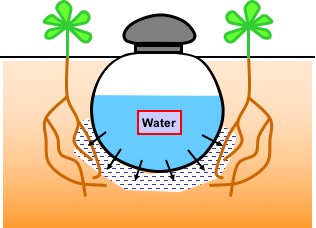Final Project: Clay Pot Irrigation
(work in progress)
Origins
Clay pot irrigation is a technique that reaches out 4,000 years back into the African continent. The idea is simple: for an efficient, water saving way to irrigate crops, people bury unsealed pottery next to the plant, fill it with water and close it. According to the organic content of the original clay mixture from which the pottery was made, this water oozes more or less slowly through the pores of the vase (Fig.01). High organic content leaves more pores and thus causes stronger irrigation.
 |
 |
Fig.01: Principle of clay pot irrigation |
Fig.02: Manually produced clay pots |
During our field work on the Green Desert Project in Lima (Peru), my wife Anne Lummerich and I experimented with clay pot irrigation and became absolutely convinced of its benefits. However, it was still a laborous business to carry 4 liters of water to 800 trees scattered on some hills of poor Lima suburbs once a week. It was back then already that we wished for some sort of automation. In addition, the clay pots we had ordered from manual production (Fig.02) were nice but not entirely reliable regarding the water flow rate. Both shortcomings I want to address with my final project.
Downscaling the Lima field situation
Fig.03 displays the situation upon which my project is based: three (out of originally 800) irrigation units (drought tolerant local tree species) surrounded by 3 clay pots each (4). The clay pots are connected to the water reservoir (1) by tubes and hoses (3) that all merge in one distribution unit (2). This unit receives signals from an Arduino-compatble soil moisture sensor (5) and operates its valves to fill the clay pots according to the soil moisture deficit.

Fig.03: Concept for clay pot field irrigation system based on Green Desert pilot study
Due to the apparent lack of a reforestation site on water-deprived hills, I chose a much simpler approach: an in-house clay pot irrigation system for automated water supply over up to 6 weeks of absence. This laboratory scale version allows not only to gather experience with measurement and control units plus the production of water resistant casings to be exposed to potentially aggressive climates; it also introduces a reproducible fabrication of irrigation clay pots. As indicated above, current suppliers cannot guarantee a stable water flow rate. This may be addressed by choosing 3D clay printing with properly defined input material under fixed and reproducible conditions.
